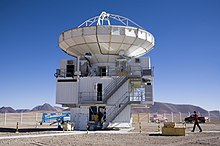Atacama Pathfinder Experiment

The APEX telescope
|
|
| Organisation | Max Planck Institute for Radio Astronomy (50%), Onsala Space Observatory (23%), ESO (27%) |
|---|---|
| Location(s) | Chajnantor plateau, Chile |
| Coordinates | 23°00′21″S 67°45′33″W / 23.0058°S 67.7592°WCoordinates: 23°00′21″S 67°45′33″W / 23.0058°S 67.7592°W |
| Altitude | 5,100 m |
| Wavelength | millimetre and submillimetre (0.2 to 1.5 mm) |
| First light | 2004 |
| Telescope style | Cassegrain |
| Diameter | 12-metre antenna |
| Mounting | altazimuth |
| Website |
www |
|
|
|
|
[]
|
|
The Atacama Pathfinder Experiment (APEX) is a radio telescope 5,100 meters above sea level, at the Llano de Chajnantor Observatory in the Atacama desert in northern Chile, 50 km east of San Pedro de Atacama built and operated by 3 European research institutes. The main dish has a diameter of 12 m and consists of 264 aluminium panels with an average surface accuracy of 17 micrometres (rms). The telescope was officially inaugurated on September 25, 2005.
The APEX telescope is a modified ALMA (Atacama Large Millimeter Array) prototype antenna and is at the site of the ALMA observatory. APEX is designed to work at sub-millimetre wavelengths, in the 0.2 to 1.5 mm range — between infrared light and radio waves — and to find targets that ALMA will be able to study in greater detail. Submillimetre astronomy provides a window into the cold, dusty and distant Universe, but the faint signals from space are heavily absorbed by water vapour in the Earth's atmosphere. Chajnantor was chosen as the location for such a telescope because the region is one of the driest on the planet and is more than 750 m higher than the observatories on Mauna Kea and 2400 m higher than the Very Large Telescope (VLT) on Cerro Paranal.
APEX is a collaboration between the German Max Planck Institute for Radio Astronomy (MPIfR) at 50%, the Swedish Onsala Space Observatory (OSO) at 23%, and the European Organisation for Astronomical Research in the Southern Hemisphere (ESO) at 27%. The telescope was designed and constructed by the German firm VERTEX Antennentechnik GmbH, under contract by MPIfR. The operation of APEX on Chajnantor is entrusted to ESO.
Submillimetre astronomy is a relatively unexplored frontier in astronomy and reveals a Universe that cannot be seen in the more familiar visible or infrared light. It is ideal for studying the "cold Universe": light at these wavelengths shines from vast cold clouds in interstellar space, at temperatures only a few tens of degrees above absolute zero. Astronomers use this light to study the chemical and physical conditions in these molecular clouds — the dense regions of gas and cosmic dust where new stars are being born. Seen in visible light, these regions of the Universe are often dark and obscured due to the dust, but they shine brightly in the millimetre and submillimetre part of the spectrum. This wavelength range is also ideal for studying some of the earliest and most distant galaxies in the Universe, whose light has been redshifted into these longer wavelengths.
...
Wikipedia
